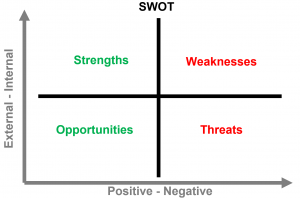What is SWOT?
SWOT stands for Strengths, Weaknesses, Opportunities, and Threats.
It is a very popular tool used for reporting the strategic analysis of a company. And I say for reporting because, in fact, it does not give us the means for making the previous analysis.
The main characteristic of this tool is that it classifies all the relevant facts or characteristics of each situation in two axis: positive or negative, internal or external.

Being:
- Strengths: Characteristics or capacities of the organization that make it more probable to succeed than its competitors.
- Weaknesses: Characteristics or internal impediments that make the organization more probable to be outgained by its competitors or to fail in its goals.
- Opportunities: External characteristics or situations which specifically make this organization more probable to achieve its goals, instead of its competitors.
- Threats: External characteristics or situations which specifically make this organization more prone to fail in the achievement of its goals.
In this way, even without a previous analysis with any other tool or framework, it can be the basis of workshops or brainstormings, helping the participants in thinking of positive and negative aspects affecting the organization and whether they are internal or external to the organization.
Assessing whether the identified factors are internal or external is particularly relevant, and thus the popularity of this tool. In the end, if we have a weakness, we can work internally to overcome it and transform it into a strength, or at least improve it. But if we have an external threat, we might not be able to change it, and we just need to decide how to live with it.

